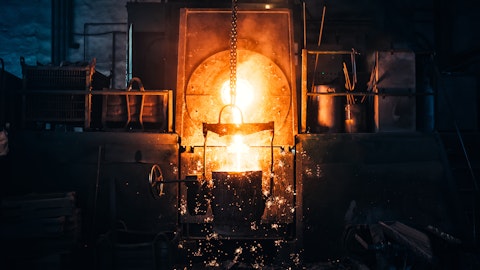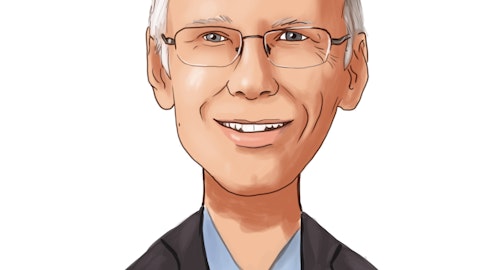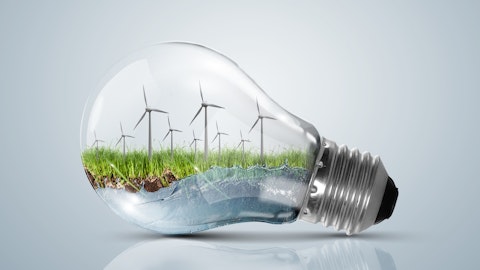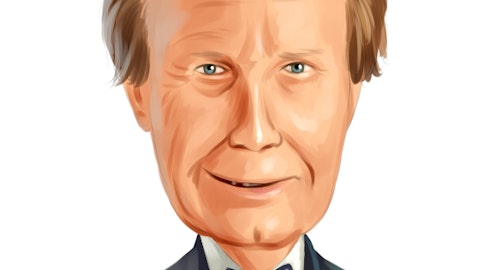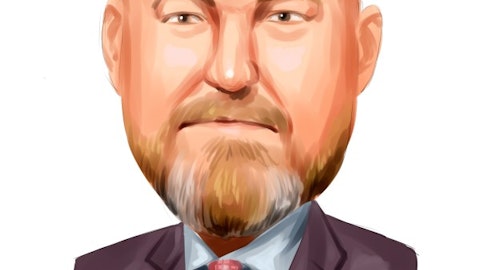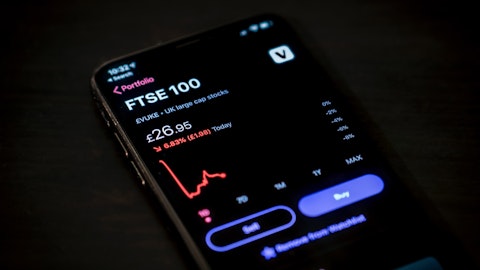American Superconductor Corporation (NASDAQ:AMSC) Q3 2022 Earnings Call Transcript February 2, 2023
Operator: Good morning, and welcome to the AMSC Third Quarter Fiscal Year 2022 Financial Results Conference Call. Please note, this event is being recorded. I would now like to turn the conference over to John Heilshorn from LHA. Please go ahead.
John Heilshorn: Thank you, Gerry. Good morning, everyone . And welcome to American Superconductor Corporation’s third quarter of fiscal 2022 earnings conference call. I am John Heilshorn of LHA Investor Relations, AMSC’s Investor Relations agency of record. With us on today’s call are Daniel McGahn, Chairman, President and Chief Executive Officer; and John Kosiba, Senior Vice President, Chief Financial Officer and Treasurer. American Superconductor issued its earnings release for the third quarter of fiscal 2022 yesterday after the market closed. For those of you who have not been able to see the release, a copy is available at the Investors page of the company’s website at www.amsc.com. Before starting the call, I’d like to remind you that various remarks that management may make during today’s call about American Superconductor’s future expectations, including expectations regarding the company’s fourth quarter of fiscal 2022 financial performance, plans and prospects, constitute forward-looking statements for purposes of the safe harbor provisions under the Private Securities Litigation Reform Act of 1995.
Actual results may differ materially from those indicated by such forward-looking statements as a result of various important factors, including those set forth in the Risk Factors section of American Superconductor’s annual report on Form 10-K for the year ended March 31, 2022, which the company filed with the Securities and Exchange Commission on June 1, 2022, and the company’s other reports filed with the SEC. These forward-looking statements represent management’s expectations only as of today and should not be relied upon as representing management views as of any date subsequent date to today. While the company anticipates that subsequent events and developments may cause the company’s views to change, the company specifically disclaims any obligation to update these forward-looking statements.
Also on today’s call, management will refer to non-GAAP net loss, a non-GAAP financial measure. The company believes that non-GAAP net loss assists management and investors in comparing the company’s performance across reporting periods on a consistent basis by excluding these noncash, nonrecurring or other charges that it does not believe are indicative of its core operating performance. The reconciliation of GAAP net loss to non-GAAP net loss can be found in the third quarter of fiscal ’22 earnings press release that the company issued and furnished to the SEC last night on Form 8-K. All of American Superconductor’s press release and SEC filings can be accessed from the Investors page of its website at www.amsc.com. With that, I will now turn the call over to Chairman, President and Chief Executive Officer, Daniel McGahn.
Daniel?
Daniel McGahn: Thanks, John, and good morning, everyone, and thank you for joining us. I’ll begin today by providing an update and sharing a few remarks on our business. John Kosiba will then provide a detailed review of our financial results for the third fiscal quarter, which ended December 31, 2022. And we’ll provide guidance for the fourth fiscal quarter, which will end March 31, 2022. Separately, John will update our operating models and talk about actions we took that are expected to lower operating expenses. Following our comments, we’ll open up the line to questions from our analysts. During our third quarter of fiscal year 2022, we are delivering on our strategic priority of a more diversified business. Total revenues for the third quarter of fiscal year 2022 came in within our guidance range.
Our third quarter revenue of nearly $24 billion was driven by new energy power system shipments. Our grid segment revenue for the third quarter of fiscal year 2022 accounted for over 85% of AMSCs total revenue. The remainder of the revenues came from our wind business. During our third quarter, we saw a diverse set of product shipments. We shipped voltage compensators capacitor banks, harmonic filters, transformers rectifiers, volt-var optimizers, ship protection systems and electrical control systems. These products went into renewables and a variety of industrials markets, including semiconductor mining, as well as our navy projects. We ended the third quarter with more than $30 million in cash. And I’m happy to announce that we have met our obligations in the Chicago project.
The $5 million of restricted cash for the resilient electric grid project in Chicago are expected to become unrestricted and hit our books during our fourth quarter of this fiscal year 2022. During our third quarter, we booked $43 million of new orders and grew our backlog to over $110 million. Our backlog at the end of the third quarter increased by nearly 40%, when compared to the same quarter, a year ago. We announced our ship protection system contract with Huntington Ingalls to be deployed on the San Antonio Class Amphibious ship LPD-32. The LPD-32 contract marks AMSCs fifth ship protection system for the San Antonio class ship platform. Over the past several years, we’ve taken a series of very deliberate actions to diversify our business and grow through our grid business.
Over a four year period, we doubled our business. Over the same period, we nearly tripled our grid business. Fiscal year 2022 has been a year of transition for the company to a broader product portfolio, pricing and cost changes were possible and aligning our fixed costs better with historical revenues. John Kosiba will provide more color on this today. We have expanded the markets we serve and that has translated into a higher order intake rate. We do not intend to stop here. We have a lot of work ahead of us but our longer term priority is to build a sustainable business that’s well positioned to not only take advantage in renewables, but also in semiconductor, mining and materials, as well as in defense. We believe that this sustainable business is not so far off in the future.
John is going to update our operating models later in the call. I will provide a deeper review of some of the drivers of our business going forward. For now, I’ll turn the call over to John Kosiba to review our financial results for the third quarter of fiscal year 2022 and provide guidance for the fourth quarter of fiscal year 2022 which will end March 31, 2023. John?
John Kosiba: Thanks, Daniel. And good morning everyone. AMSC generated revenues of $23.9 million for the third quarter of fiscal 2022 compared to $26.8 million in the year ago quarter. Our grid business unit accounted for 87% of total revenues, while our win business unit accounted for 13%. Grid business unit revenues decreased by 17% in the third quarter versus the year ago quarter, while our win business units increased by 76% over the same time period. Looking at the P&L in more detail, gross margin for the third quarter of fiscal 2022 was 2% compared to 13% in the year ago quarter. Gross margin for this quarter was adversely impacted by the continued drag on logins associated with acquired Neeltran backlog. Additionally, one of our larger projects at Neeltran required additional cost to complete than we had originally planned.
This required approximately 900,000 of additional unanticipated costs in the quarter. We do not anticipate any of these costs reoccurring in Q4 as that project is now in the final stages of production. To help provide some quantitative reference as a result of several lost contracts associated with our acquired Neeltran backlog which includes the project I just discussed. Our third quarter reported consolidated gross margins have been adversely impacted by approximately 660 basis points. We believe that Q3 fiscal 2022 will be the peak of the drag from Neeltran acquired backlog. We anticipate Neeltran gross margins to improve in Q4 and further strengthen into fiscal 2023 as we begin to execute on the new project sold post production – post acquisition, sorry.
Moving on to operating expenses, R&D and SG&A expenses for the third quarter of fiscal 2022 were $9.3 million, compared to $9.4 million in the year-ago quarter. Approximately 15% of R&D and SG&A expenses in the third quarter of fiscal 2022 were non-cash. Our non-GAAP net loss for the third quarter of fiscal 2022 was $7.7 million or $0.27 per share, compared with $4.6 million or $0.17 per share in the year-ago quarter. Our net loss in the third quarter of fiscal 2022 was $9.6 million or $0.34 per share. This compares to a net loss of $4.3 million or $0.16 per share in the year-ago quarter. Please see a press release issued last night for a reconciliation of GAAP to non-GAAP results. We ended the third quarter of fiscal 2022 with $31.4 million in cash, cash equivalents and restricted cash.
This compares with $37.4 million on September 30 2022. Our operating cash burn in the third quarter of fiscal 2022 was $5.5 million. Now turning to our financial guidance. For the fourth quarter of fiscal 2022, we expect that our revenues will be in the range of $27 million to $30 million on net losses expected not to exceed $8 million or $0.28 per share. Our non-GAAP net loss is expected not to exceed $6 million or $0.21 per share. We expect operating cash flow to be a burn of $4 million to $6 million in the fourth quarter of fiscal 2022. We expect to end the fourth quarter with greater than $25 million in cash, cash equivalents and restricted cash. Now I’d like to take a few moments to update you on several strategic steps we have undertaken over the past 30 days that are expected to lower our cash flow breakeven revenue targets.
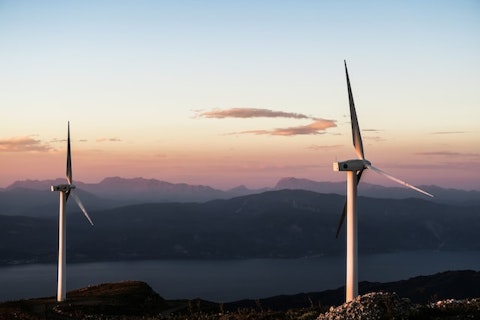
Photo by Jason Blackeye on Unsplash
Our revenue product mix has evolved as a result of the two acquisitions from what was once heavily dependent on the renewable market to a much more diversified revenue stream. It took some time to integrate both NEPSI and Neeltran to the point that we have now experienced some operating leverage across the Grid segment. As a result, we have taken several steps that are expected to lower both our manufacturing and SG&A overhead costs. These steps ranged from combining positions which were redundant across multiple product lines to leveraging our engineering and SG&A costs across the entire company. This has in part enabled us to undertake an organizational realignment and to reduce our workforce across multiple product lines. We anticipate an annualized savings of $5 million resulting from these actions.
Our business outlook for the fourth quarter does not contemplate any severance related costs for the reduction in workforce actions, which are expected to be no more than $1 million. We expect to experience the full impact of these anticipated savings starting in Q1 FY 2023. Now let me further elaborate and how this is expected to impact our cash flow breakeven scenarios moving forward. As we move into the start of FY 2023, we expect short-term cash gross margins to approach the upper teens. As we move further into FY 2023, we see scenarios where cash gross margins could reach 20%, if our revenue approaches $30 million, and we have several scenarios where cash gross margins approach 25%, if revenue approaches $35 million. These cash gross margin scenarios are a result of actions we have taken over the past year to raise our prices, coupled with what we believe is stabilized raw material costs.
We will continue to be vigilant in both our pricing models and proactive to any changes in raw material costs as we move into FY 2023. Moving along to our operating expense models, we anticipate our cash operating expenses will be approximately $9 million a quarter, once the full extent of our recent cost reduction steps are realized. When you combine the anticipated gross margin improvement with our updated operating expense profile, we see revenue breakeven scenarios in the $35 million quarterly range. These scenarios are based on current assumptions which are subject to change. Please note this is not financial guidance. This is meant more to help our shareholders understand our current forecast and operating model. We will continue to provide our current quarterly financial guidance when we announced our earnings for the prior quarter.
With that, I’ll turn the call back over to Daniel.
Daniel McGahn: Thanks, John. We have macro trends in the market that are starting to drive our business. Our backlog is over $110 million and our pipeline of prospective orders reflects our growing and diversified company. We have doubled our new energy power systems order intake rate. These macro trends are driven by climate and environmental policies, which raised demand for our new energy power systems. More specifically, our diversified pipeline of orders come from investments in renewables, and industrial markets such as semiconductors, and mining, metals, and materials. Our company has transitioned from almost a pure play in wind, to a company that’s focusing on grid resiliency. We now have multiple plays at multiple points in the power infrastructure.
Our voltage compensators, capacitors, harmonic filters, transformers and rectifiers can power the energy intensive factories of the future without the risk of costly power interruptions. Today, our business is about a quarter based upon renewable energy. We’ve grown the business that’s supporting power management at the substation level for the utility as well as supporting customers in the semiconductor industry. We have a variety of applications for industrial processes, and manufacturing, like mining, metals extraction, metal processing, and chemical plants. The company is moving in a direction where expects to provide more new energy power systems for more industrial users, more than half of our new energy power systems orders during the third quarter of fiscal 2022 come from industrial markets, one fourth is from renewables.
In the past, we’ve talked about sales leverage with our acquisitions. For example, if we get a $5 million order for D-VAR in semiconductor, we have the ability via NEPSI to get an additional 20% or $1 million in this case of additional revenue at similar margin in profit. When we look at the sales leverage in the mining and materials space, if we get a $1 million order from a mining project for NEPSI, we have the ability to get another $5 million from the leverage of Neeltran’s product line. This is five times expansion of revenues. I state the example with NEPSI first followed by Neeltran because that was the order in which we acquired the two companies and part of what drove us to like the potential sales leverage of both companies. You can reverse the example and see similar potential leverage for mining when comparing two semiconductor projects.
For a mining and materials project that Neeltran would generate, say $5 million, we’re able to expand those revenues by another $1 million from NEPSI, we are working to make those also be at similar margin levels. We believe that we are almost through that. We have a handful of Neeltran projects we need to deliver on in our fourth quarter of fiscal 2022 which is part of the guidance. I have been asked about potential operating leverage and synergies between the operations that were acquired, and the historical business. My answer has been no up until now. The team has worked diligently on driving operational leverage between the business lines, we are seeing that now coming to fruition due in part to this leverage. During the fourth quarter, we were able to tremble we expect to be approximately $5 million from our annual operational expenses beginning in fiscal 2023.
This is expected to help us get better financial leverage from the business. We believe that this helps put us on a better foot forward financially. We discussed the impact of the Neeltran backlog on our financials. This is something we have largely worked through. And I want to reassure you that going forward, we feel very confident about prospective margins. With that, I’ll move on to our ship protection systems. In an age of increasing global tensions, we’re helping to move U.S. Navy ships into the future by installing protection systems that help them stay hidden from our enemy’s threats. Our ship protection systems or SPS provides a solution that masks the ship from harm’s way, when an operation like stuff. We announced our fifth ship protection system contract for LPD-32 which has become the baseline design for the San Antonio Class Amphibious Ship Platform.
Right now, we are installing our first ship protection system on the USS Fort Lauderdale. This is something the Navy and our shipyard partner are monitoring closely. We are preparing to deliver on our second ship contract the USS Harrisburg. We currently have orders for the USS Harrisburg, the USS Pittsburgh, the USS Richard McCool and the recently added LPD-32. SPS contributed nearly 10% of revenues in the third quarter of fiscal 2022 and has been a very consistent source of grid revenue for several quarters. Our team is focused on continuing to expand our ship protection systems into other end vessels while we install our initial systems. As I have mentioned in the past, we are working on developing additional content that could be inserted in the future fleet.
We hope to have some news very soon on our progress here. On our resilient electric grid or REG system in Chicago, it continues to perform very well. In fact, we received notification from the utility that the system met specify performance requirements, and as a result, we expect to see the return of a $5 million bond which was held until the REG system passed this important accomplishment. The performance bond was structured as a letter of credit. This letter of credit is expected to hit our books during the fourth quarter of fiscal year 2022. We continue to see strong desire from this utility, as well as others to further deploy Reg into the power grid. It is clear at least to us that Reg offers the capability and functionality to solve some of the nation’s current critical grid infrastructure problems right now.
This initial project has provided tremendous learning and it’s clear to me that utilities are thinking about Reg as a viable product. Turning to wind, we are supporting Inox with the initial prototype of a three megawatt class wind turbine and Doosan with the initial wind farm of 5.5 megawatt wind turbines. During the third quarter of fiscal 2022, we shipped two megawatt electrical control systems to our partner in India Inox Wind. You can see that Inox was just over 10% of our revenues this quarter. The design certificate of the three megawatt class wind turbine prototype for the Indian market is complete. We are now working on the type certification and hopefully will report back to you soon on our progress. Type certification means that the three megawatt class wind turbine will be able to connect to the power grid.
It’s worth noting that towards the end of 2022 Inox did announce the completion of a capital raise of about 15 billion rupee, which translates into something on the order of about $180 million. We believe Inox is closer to expanding its business with the three megawatt class wind turbine this calendar year, which we expect will translate into an expanded order book for us. We hope to be reporting progress in the near future. To conclude, we have built a diversified business that we believe is well positioned to capitalize on future investments in renewables, future investments in semiconductors, future investments in electric vehicles, and the mining of the materials that go into these three markets, as well as the defense business. We are driven by the opportunities that climate change, present to us, as well as the electrification of transportation.
Our products provide support to the grid at the power consumption point of the electric vehicle, as well as the operations that provide the metals and materials used to build the vehicles. We evolve from being a very concentrated business with both customer and market concentration to a more diverse business, all at the same time growing revenues. We are focused on improving the financial performance of the business, continuing to deliver a diversified business and making progress towards our longer term priority of building a sustainable business. I think the team has done a terrific job of achieving this. We understand the broader geopolitical environment is mixed with uncertainty surrounding the supply chain constraints, inflation, recession, and stock market volatility.
When we look at our prospects, our sales pipeline appears to be strengthening, not weakening. Orders are becoming larger, not smaller. The types of markets we serve are becoming more diverse, less concentrated. So when I look at the near term, say the next year or so, I think our prospects are great. As we look ahead into the fiscal year 2023. I am optimistic that our recently announced backlog will result in a more diversified and financially stronger AMSC. You can see from the backlog, and John’s commentary on our operating models, that we are nearly there. We believe that our differentiated solutions and set of capabilities are a significant advantage that will allow us to serve our customers even more efficiently. I want to thank our team for their hard work and support.
And I look forward to reporting back to you, at the completion of our fourth fiscal quarter and fiscal year end of 2022. Gary will now take questions from our analysts.
See also 25 Lowest PE Stocks of S&P 500 Index and 11 Most Undervalued Blue Chip Stocks To Buy .
Q&A Session
Follow American Superconductor Corp (NASDAQ:AMSC)
Follow American Superconductor Corp (NASDAQ:AMSC)
Operator: Our first question comes from Eric Stine with Craig Hallum. Please go ahead.
Eric Stine: Hi, Daniel, hi, John.
Daniel McGahn: Hi Eric, good morning nice having –
Eric Stine: Hi good morning. Maybe just on the Reg milestone if you’re able to maybe some details on exactly what that milestone is. And, you know, potential read through to next steps. You know, I recently actually yesterday saw that Chicago and ComEd announced a pretty wide ranging agreement it included a lot of energy initiatives and grid investments. So curious, you know, maybe your confidence level or what type of visibility you might get that for this milestone into the next steps?
Daniel McGahn: Yes, I mean, to be blunt, my confidence is very, very high. I think you know, the good news about Reg is and we’ve designed the business in a way financially, the Reg is not necessary to meet, you know, our margin projections and kind of the near term financial aspects of the business. But looking at the longer term, this is a huge milestone for the company it means the systems performed as advertised. It means that the utility has been able to work with their constituents, specifically regulators and all the local politics they have to deal with, where this is now a permanent part of the grid it has been accepted. The number of people that they brought there that work for the utility, the number of people that they brought there that work for other utilities has been staggering.
Their efforts all along have been to look at this first project as a stepping stone to a future with superconductivity. Everything that we see everything that we’re told, everything we’ve been shown, leads us to believe that there’s a very bright future for Reg in many, many cities in the country. This is a huge milestone for the company. I think the hardest challenge, though, is to predict or handicap over time, how will this progress? Utilities are notoriously slow. You know, negotiating contracts that we do today for any of our other products take a longer time than many of the markets that we serve. But, you know, I think when we look back about embarking on to this product Reg, we really have met a tremendous milestone we have a system that’s in the grid that’s been accepted by the utility and expected – and accepted by, you know, all of their constituencies, which I think is huge for the product it means we really have a product we can go and sell going forward.
Eric Stine: Got it. And I can appreciate the lack of, you know, timing visibility. But if you had to handicap it, I mean, do you think especially given all of the parties that have come in and looked at this deployment? I mean, do you think that that second Chicago project is next or would you expect, you know, as you’ve talked about diversity and diversity of customer, would you expect it to potentially be another utility?
Daniel McGahn: I really can’t handicap that – other than saying we’re working in parallel with multiple cities right now on projects that solve compelling problems in the grid right now. And we see Reg as really the only solution, if they want to solve these in the near term.
Eric Stine: Got it, okay. Maybe last one, from me just appreciate the commentary on the breakeven given your backlog pipeline, and you know, the potential for quicker turn business. I mean, when you think about that breakeven number you think that you can get there, you know, on the grid momentum alone, with wind kind of in its current state, or when you get there, do you anticipate that wind would be a meaningful part of it as well?
